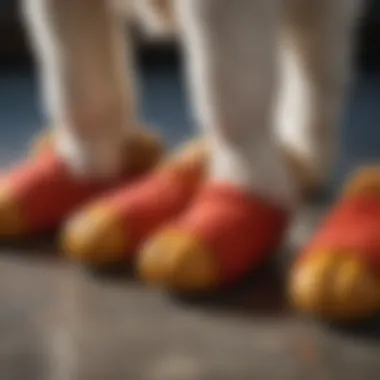Protect Your Pup: Choosing Dog Paw Booties for Hot Pavement


Intro
As temperatures rise during the summer months, dog owners face the challenge of keeping their pets comfortable and safe. One critical yet often overlooked aspect is protecting dog paws from scorching pavement. The risk of burns or injuries increases significantly when dogs walk on hot surfaces. This article examines the necessity of dog paw booties, the variety of options available, and how to select the best choice for your canine companion. With this knowledge, you can help ensure the health and safety of your pet.
Pet Care and Grooming
Importance of Regular Care
Regular care of a pet’s paws is essential, especially in warm weather. Hot pavement can lead to injuries that may not be immediately visible. Checking the condition of your dog’s paws must be an integral part of their grooming routine.
Grooming Techniques
Different grooming techniques are required based on the type of pet. For dogs, regular nail trimming, fur brushing, and cleaning between the paw pads are vital. While grooming, pay attention to the pads for any signs of wear or irritation.
Tools and Products Recommendations
Investing in quality grooming tools can make a significant difference. For paw care, use:
- Soft-bristle brushes for cleaning fur and debris.
- Nail clippers designed for dogs.
- Moisturizing paw balms that can help nourish and protect the pads when booties are not in use.
Seasonal Care Tips
Seasonal changes require adjustments in grooming routines. In the summer, it is important to examine your dog’s paws more frequently. Rinsing the paws with cool water after walks can help reduce the risk of irritation from hot surfaces. When necessary, use booties to offer protection and comfort.
Health and Nutrition
Understanding Pet Nutrition
While discussing paw health, it is equally valuable to understand overall pet nutrition. A balanced diet contributes to healthy skin and coat, which can support overall foot health.
Common Health Issues by Species
Dogs can face various health issues, some of which may affect their paws, including allergies or infections. Being aware of the specific conditions that can impact your breed helps in prevention and early detection.
Preventive Care and Regular Check-Ups
Regular veterinary visits are crucial for maintaining your dog's health. Discuss any concerns regarding paw care or injuries during these check-ups.
Food and Dietary Advice
Consider supplements that support skin health, such as omega-3 fatty acids. These can help improve the quality of your dog's coat and skin, which can also reflect positively on paw health.
Behavioral Training
Basics of Positive Reinforcement
Training should not be neglected when it comes to equipping your dog with booties. Use positive reinforcement to create a comfortable association with them. Reward your pup for wearing booties to reduce resistance.
Training Techniques
Start by letting your dog explore the booties indoors. Gradually increase exposure time and area. Short walks can help your dog adapt to the feel of the booties.
Managing Behavioral Issues
Some dogs may resist wearing booties initially. Be patient. Understand that fear and anxiety can play a role in this behavior. Gradual exposure is key.
Importance of Socialization
Including booties in social scenarios can normalize their use. Walking with other dogs that wear booties can help your pet accept them more easily.
Engaging Activities and Enrichment


Fun Games to Play with Your Pet
Engagement is crucial for mental stimulation. Use the booties for activities in the backyard or at a dog park. Simple games can make them a more accepted part of your dog’s experience.
DIY Toys and Activities
Creating toys that can be used outdoors while wearing booties helps with acclimatization. Engage your pet’s mind and body with new activities where booties can be beneficial.
Importance of Mental Stimulation
Booties can be part of your regular walking routine, which provides both physical and mental enrichment for your dog. Exercise is especially important during the hot summer months.
Outdoor Adventures and Exploration
Plan trips to shaded areas or dog-friendly parks, where you can use booties. This way, your dog can experience the great outdoors safely.
Resources and Community Engagement
Recommended Books and Websites
For further reading, explore resources such as Wikipedia Dog_(domestic)) and Britannica's articles on Pets.
Forums and Groups for Pet Owners
Join online communities such as Reddit’s r/dogs for sharing tips and experiences with dog booties and caring for your pets.
Finding Local Services and Classes
Seek local dog training classes that incorporate equipment handling. Local veterinarians can also offer advice on paw health and booties.
Encouraging Community Sharing and Contributions
Sharing experiences with your local pet community can be beneficial. Solutions to common issues can be more easily found through community interactions.
Remember, your dog’s paw health is crucial for their overall well-being. Investing time in understanding booties and their benefits is essential for happy walks during hot days.
Understanding the Importance of Paw Protection
Taking care of a dog means considering every part of its body, including its paws. For dogs, paw protection becomes essential, especially during hot months. The ground can heat up quickly, and dog paws are sensitive to temperature extremes. Unprotected exposure to hot pavement can lead to serious injuries. Therefore, understanding the necessity of paw protection is critical for responsible pet ownership.
The Anatomy of a Dog's Paw
A dog’s paw consists of several parts: the pads, toes, and nails. The pads are the most significant elements, providing cushioning and protection. They are made of skin, similar to human feet, but they can withstand wear and tear effectively. However, the pads can only endure so much heat. The toes help with balance and traction while the nails protect the paw and ground the dog's body during movement. Maintaining the health of these anatomical features is paramount to ensuring comfort and mobility.
Effects of Hot Pavement on Dog Paws
Hot pavement can cause significant harm to a dog's paws. Temperatures can soar well above the air temperature, leading to burns or even blistering. Since dogs naturally do not wear shoes, they are directly susceptible to this kind of injury. When the surface is too hot, it can also lead to impaired movement or a reluctance to walk, affecting the dog's overall activity levels. Moreover, persistent exposure to these conditions can result in long-term damage to the paw pads, decreasing their protective ability.
Signs of Paw Damage in Dogs
Dog owners should be vigilant for signs of paw damage. Common indicators include limping, licking or chewing at the paws, or avoiding walking on hot surfaces. If a dog is holding up a paw or seems to be reluctant to step outside, it may indicate discomfort. Visible signs such as redness, blisters, or cracks on the paw pads are immediate calls for concern. Recognizing these symptoms helps in providing appropriate care and protection to prevent further damage.
Key Insight: Regular checks on your dog’s paws, especially after walks, can help catch issues early. Protective measures like booties can prevent injuries that might otherwise go unnoticed.
Types of Dog Paw Booties Available
Understanding the different types of dog paw booties is essential for ensuring your dog's comfort and protection. Booties are designed to shield paws from hot pavement, sharp objects, and other potential hazards. Choosing the right type can make the difference between a comfortable walk and an unpleasant experience for your pet. This section looks into material considerations and common designs, laying out clear attributes that will help in making informed choices.
Fabric and Material Considerations
Selecting the right fabric and material for dog paw booties is vital. The construction directly impacts the efficiency, comfort, and usability of the booties. Here are the key factors to consider.


Durability
Durability is a critical aspect when it comes to dog paw booties. Robust materials such as heavy-duty nylon or reinforced rubber are commonly utilized. These fabrics withstand wear and tear from various terrains. A durable bootie ensures that it lasts longer and offers more extended protection, which is particularly important for active dogs or those taken on rugged walks. Some booties offer a lifetime guarantee, signifying a strong commitment to durability.
Breathability
Breathability refers to the ability of the material to allow air circulation. A breathable bootie prevents excessive heat accumulation, ensuring your dog's feet remain comfortable during walks on hot surfaces. Booties made from mesh or airy fabrics provide better ventilation, which can be crucial in avoiding overheating. However, a balance must be struck between breathability and protection, as overly breathable materials may compromise foot safeguarding.
Water Resistance
Water resistance is another important characteristic. Though primarily booties are used in hot weather, instances of encountering damp or wet spots on your walks are common. The ability to repel moisture helps maintain paw health. Booties made from waterproof materials will keep the paws dry and clean. However, it's worth noting that water-resistant booties might reduce breathability, necessitating careful selection for climates where humidity is a factor.
Common Bootie Designs
The design of dog paw booties plays a significant role in determining their ease of use and effectiveness. Various designs cater to different needs, making it easier for owners to find something that fits their dog's requirements well.
Slip-On Booties
Slip-on booties are popular for their simplicity. They can be easily put on and removed, which is especially handy for dogs that are not used to wearing booties. These are typically designed with elastic bands that secure the booties to the paws without needing additional straps. However, while this design is convenient, it may not fit snugly on dogs that tend to shake off their accessories and might require some adjustment during walks.
Velcro Booties
Velcro booties offer a secure fit thanks to adjustable straps. The use of Velcro allows for a customized snugness, essential for ensuring that the booties remain in place while walking. This design is especially beneficial for active dogs that might struggle with looser options. However, the Velcro can gather fur and dirt, requiring regular cleaning to maintain effectiveness and avoid any skin irritation.
Custom Fit Options
Custom fit options are emerging as a favored design for discerning pet owners. These booties are tailored to the specific size and shape of your dog’s paws. Such personalized designs maximize comfort and minimize movement during activities. While they usually come at a higher price point, the unique fit can enhance the overall utility and lifespan of the booties. However, finding a vendor that offers this service may require additional research.
Selecting the Right Booties for Your Dog
Choosing the appropriate booties for your dog is crucial for ensuring their comfort and safety when navigating hot pavement. Factors such as size, fit, and the nature of your dog's activities play a significant role. If the booties are too tight or too loose, they can cause discomfort and distractions. Therefore, prioritizing these elements can lead to a more enjoyable experience for both you and your canine companion.
Size and Fit Measurements
Accurate size and fit measurements are fundamental when selecting dog paw booties. To find the right size, measure your dog’s paws while standing on a flat surface. First, ensure the dog is relaxed, as this will give the most truthful measurement. Use a tape measure to measure the width and length of the paw.
Most manufacturers provide a sizing chart based on paw measurements. Make sure to refer to this before purchasing. If your dog is between sizes, opt for the larger one. A snug yet comfortable fit is what you should aim for. This will prevent the booties from slipping off during walks.
Assessing Your Dog's Activity Level
Understanding your dog's activity level is equally important when selecting booties. If your dog is highly active, such as participating in daily runs or extensive walks, look for durable options that can withstand these activities. Strong and reinforced materials are more appropriate for active dogs.
On the other hand, if your dog is less active and typically enjoys short walks, lighter and more breathable booties might suffice. Be sure to consider the environment in which your dog will be wearing the booties. Sand, gravel, and uneven terrain require specialized booties.
Reviewing Customer Feedback and Ratings
Before making a final purchase, evaluating customer feedback and ratings can provide insight into the performance of the dog booties. Online reviews can highlight the pros and cons of various brands and models. Customers often share practical experiences that may point out durability issues, comfort level, or effectiveness under certain conditions.
Check out sources like Reddit or specialized pet forums to gather additional insights. Reliable reviews can assist you in making an informed decision, ensuring your dog receives the best protection possible on hot surfaces.
Understanding these elements leads to better choices for your dog's well-being.
Applying and Maintaining Dog Paw Booties
Applying and maintaining dog paw booties is a crucial aspect for pet owners who want to ensure the comfort and protection of their dogs' paws. These booties are not just accessories; they provide essential defense against hot pavement. Proper application affects how well the dog adjusts to wearing them, and maintenance ensures their longevity.
How to Properly Fit Booties on Your Dog
Fitting booties correctly is essential for both comfort and effectiveness. You should begin by measuring your dog's paws accurately. Use a measuring tape to gauge both the width and length of each paw. Be aware that the front and back paws might differ in size.
Next, consider the design of the booties; most brands will have specific fitting guides based on your dog's measurements. When placing the booties on, ensure that they are snug but not tight. There should be no excessive tension on your dog's legs. Allow some room for the natural movement of their paws. It may be helpful to encourage your dog with treats during the fitting process to create a positive association with wearing booties.


Caring for Your Dog's Booties
Cleaning Instructions
Cleaning is a vital part of caring for your dog's booties. Most booties are made from materials that can accumulate dirt and debris, which can damage the fabric over time. Regular cleaning helps in maintaining the integrity of the booties. Instructions often vary by brand, but a general guideline is to wash them with mild soap and lukewarm water.
Avoid using harsh detergents or bleach, as these can weaken the material. A gentle scrub with a soft cloth can remove stubborn stains without risking damage. After washing, allow the booties to air dry completely before storage. This method not only epitomizes good hygiene but also extends the lifespan of the booties.
Storage Tips
Storage of dog paw booties is just as important as cleaning. Keeping them in a cool, dry place away from direct sunlight can prevent material degradation. A designated storage bag or box can keep them organized and prevent loss.
It is useful to store the booties flat rather than crumpled, as this will maintain their shape. Additionally, check the booties periodically for signs of wear and tear, especially if they are not used frequently. Well-maintained booties can provide your dog with long-lasting protection, which is essential in hot weather.
Remember: The goal of applying and maintaining the booties is to ensure your pet's comfort and health during outdoor activities.
The Benefits of Using Dog Paw Booties
Dog paw booties serve multiple roles in safeguarding the health and well-being of canines during warm weather. These specially designed coverings can make a significant difference in ensuring that dogs are comfortable and protected. Understanding the benefits of using these booties can aid pet owners when making choices regarding their dog’s paw care.
Preventing Injuries and Discomfort
One of the primary advantages of dog paw booties is their ability to prevent injuries and discomfort. Hot pavement can cause burns on the sensitive pads of a dog's paws. High temperatures can lead to serious damage, including blistering and peeling skin. Booties act as a barrier, shielding the paws from extreme heat. They are particularly useful during the summer months when outdoor surfaces can reach dangerously high temperatures.
Additionally, booties protect against sharp objects, gravel, and other harmful debris that might be present on the ground. Even minor cuts on a dog's paws can lead to infections or serious complications.
Moreover, booties can also help if your dog has demonstrated a tendency to scratch or lick their paws excessively. This can prevent the exacerbation of an existing injury or condition.
Enhancing Your Dog's Confidence on Hot Surfaces
Dog paw booties play a vital role in enhancing a dog’s confidence when walking on challenging surfaces. Many dogs display hesitation when they encounter hot pavements or uncomfortable surfaces. This reluctance is natural, as they instinctively protect their paws from damage. Wearing booties can allow dogs to walk freely without the fear of painful experiences.
With the added comfort and safety of booties, dogs may feel more at ease during walks or outdoor activities. This confidence can result in longer, more enjoyable walks and a better overall quality of life. In the long-run, regular use of booties becomes a positive reinforcement that promotes happiness and activity in dogs, contributing to healthier lifestyles.
Using dog paw booties is not just a luxury; it’s a necessity for many dogs, especially in regions with soaring temperatures.
Alternatives to Dog Paw Booties
Exploring alternatives to dog paw booties is essential for pet owners who seek to protect their dogs from the harsh effects of hot pavement. While booties are effective, various other solutions can help ensure the safety and comfort of a dog's paws during warm weather. These alternatives provide pet owners with options that may suit different lifestyles or specific dog needs. More considerations are important because not every dog is comfortable wearing booties.
Dog Paw Balms and Creams
Dog paw balms and creams serve as preventative measures against hot pavement. They create a protective barrier on the skin, keeping moisture in and harmful elements out. These balms are often composed of natural ingredients, such as beeswax and shea butter, which help nourish the pads of the paws and prevent cracking. In addition to providing protection from hot surfaces, some balms also help soothe and heal existing injuries. When selecting a paw balm, look for those that are non-toxic, pet-safe, and tailored for outdoor activities. Regular application leads to better paw health, and a small amount can go a long way.
Using paw balm before walks can significantly reduce damage from hot pavement.
For the best results, follow the instructions on the product label. Applying it shortly before your outdoor adventures is advisable. This ensures that the balm has time to settle into the skin effectively.
Timing Outdoor Activities
Timing outdoor activities is another significant consideration. During the hottest parts of the day, pavement temperatures can soar, resulting in painful experiences for your dog. To avoid any discomfort, dog owners should plan walks and playtimes for early mornings or late evenings when temperatures cool down. This simple adjustment can make a considerable difference.
It is helpful to consider the following tips:
- Check pavement temperature: A good rule is to place your hand on the ground for seven seconds. If it feels too hot for you, it will likely be too hot for your dog.
- Choose shaded areas: Parks with trees or paths that are naturally shaded can help keep your dog cooler.
- Limit activity duration: Shorter walks can reduce risks while still allowing your dog to exercise.
Epilogue
In this article, we have discussed the essential elements surrounding dog paw booties specifically designed to protect a dog's paws from hot pavement. The need for such protections cannot be overstated, especially during the scorching months of summer. As pet owners, it is our responsibility to recognize the hazards that high temperatures pose not only to our environment but also to our furry friends. Understanding the impact of hot surfaces on their delicate paws is crucial.
Making Informed Decisions for Your Pet's Well-Being
When considering dog paw booties, informing oneself about the various options available is vital. Key considerations include material composition, comfort, proper fit, and ease of maintenance. Each of these factors contributes to the overall effectiveness of the booties.
Pet owners should ensure they select a product that matches their dog's specific requirements, factoring in the dog's activity level and breed. Booties with breathable materials, for instance, can prevent overheating on warm days. Additionally, the right design should allow for ease of wear while ensuring a secure fit.
"Choosing the correct booties enhances not only the comfort of your dog but also their willingness to engage in outdoor activities during the warmer months."
Another significant aspect is how to properly maintain the booties. Regular cleaning following manufacturer instructions ensures longevity and effectiveness of the product. Finally, keeping an eye on your dog's paws for any signs of discomfort, even with booties, remains important. This helps in early identification of any potential issues.















